Abstract
1. The report describes a new technique for collecting pancreatic juice in anaesthetized rats. The technique, which involves perfusion of the duodenum, is particularly suitable for analysing the characteristics of pancreatic enzyme secretion. To ensure stable secretory conditions, the rats were kept at 30° C.
2. Different combinations of secretin and cholecystokinin-pancreozymin have been given by continuous intravenous infusion and the patterns of secretion of amylase and trypsin have been defined.
3. Maximal secretion of the pancreatic enzymes was observed with 60 IU/kg.hr CCK-PZ (amylase) or 120 CU/kg.hr (trypsin) combined with 0·5 CU/kg.hr (secretin).
4. Pancreatic enzyme secretion in response to submaximal stimulation with CCK-PZ was potentiated by secretin.
5. Supramaximal stimulation with CCK-PZ resulted in significantly less secretion of pancreatic enzymes than in response to maximal stimulation.
6. The pancreatic secretion of enzymes was poorly sustained during constant-rate stimulation with intravenous hormones, at all dose rates.
7. The significance and possible mechanisms of the biphasic pattern of enzyme secretion in response to increasing doses of stimulant hormones and the fall-off in enzyme secretion during constant-rate stimulation are discussed.
Full text
PDF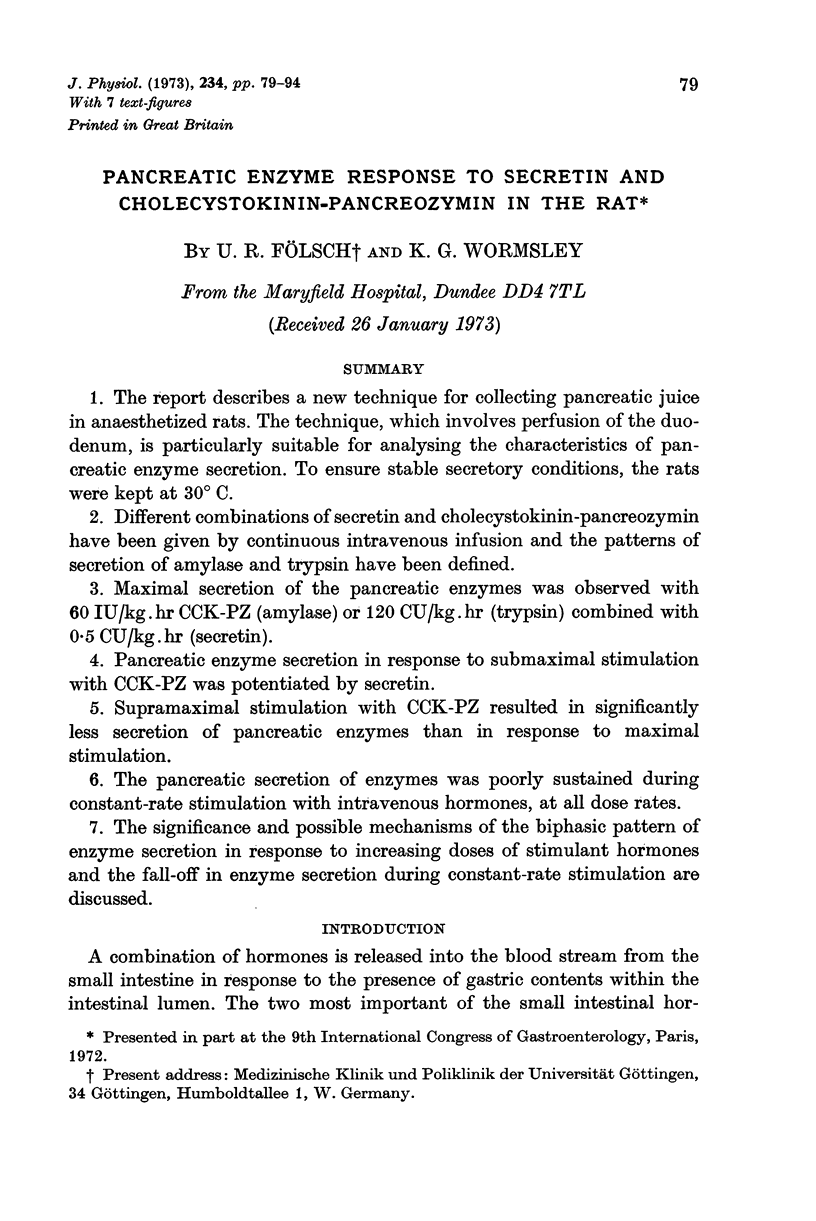
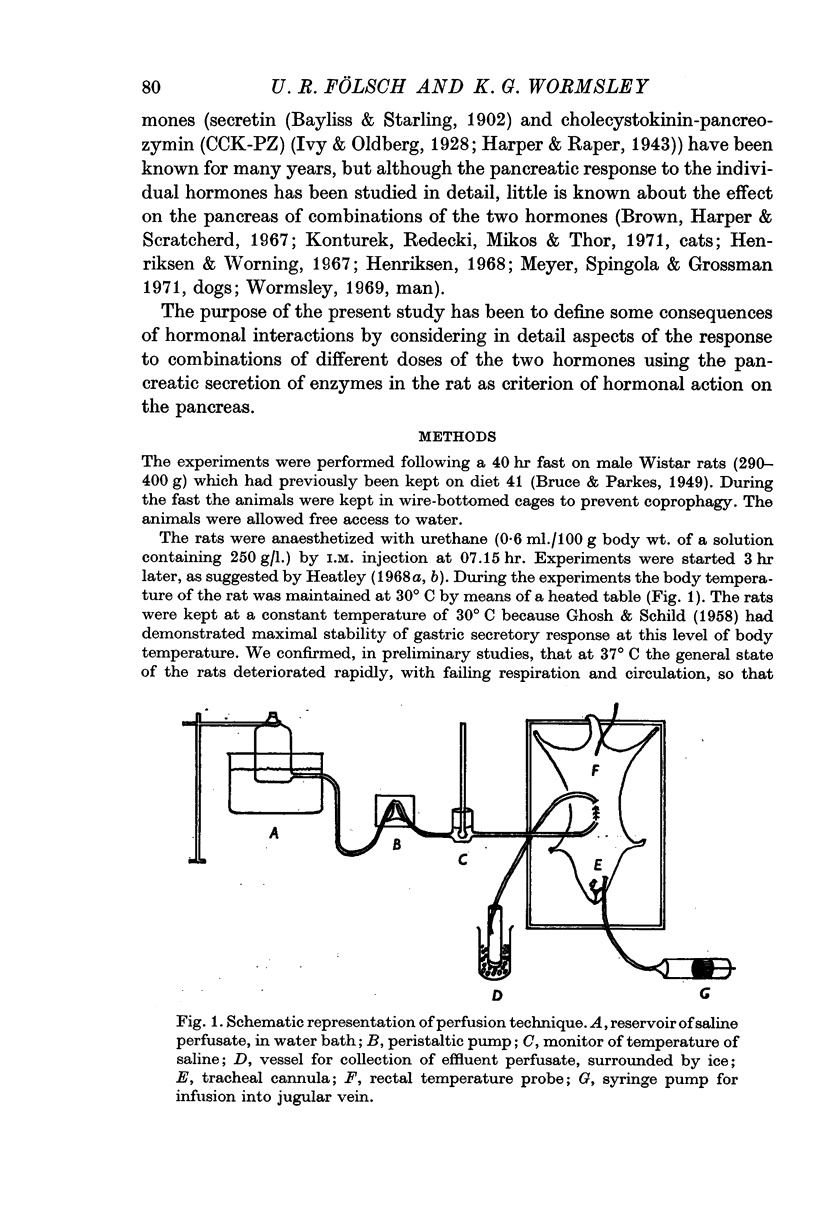
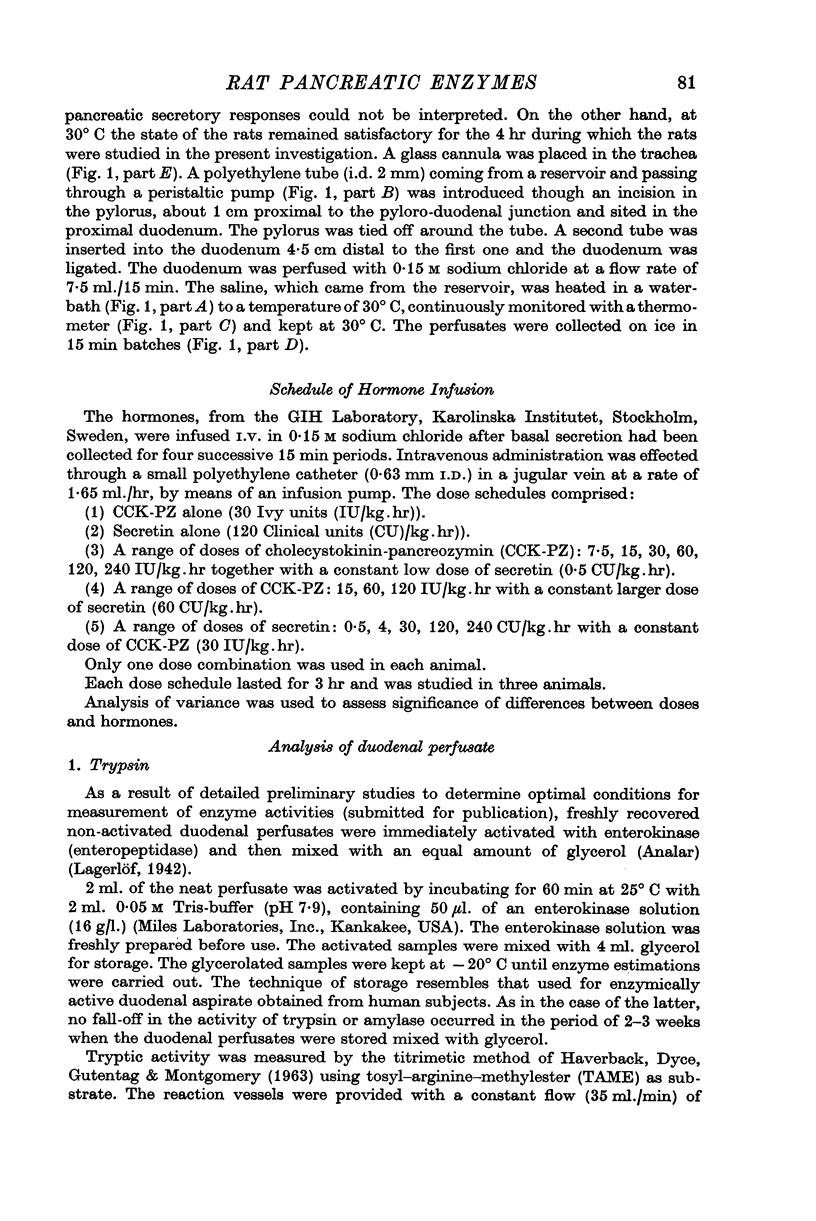

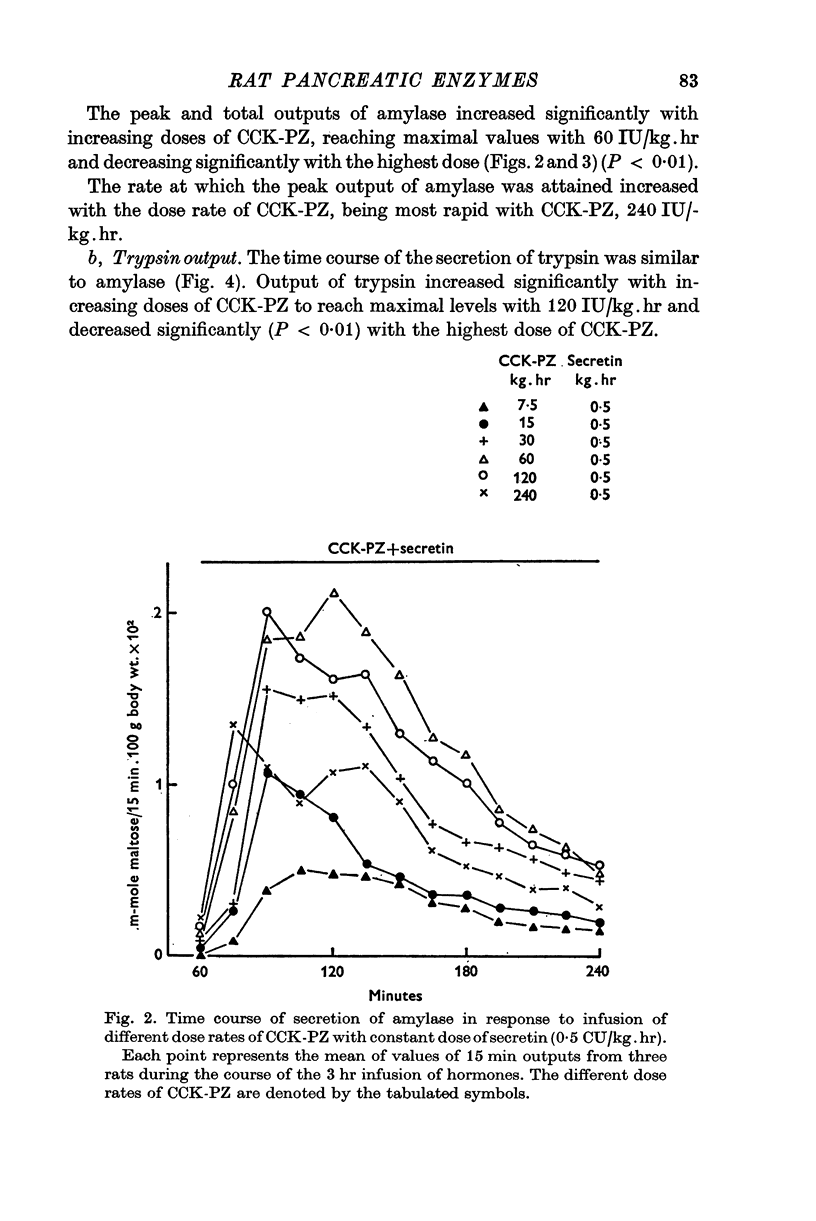
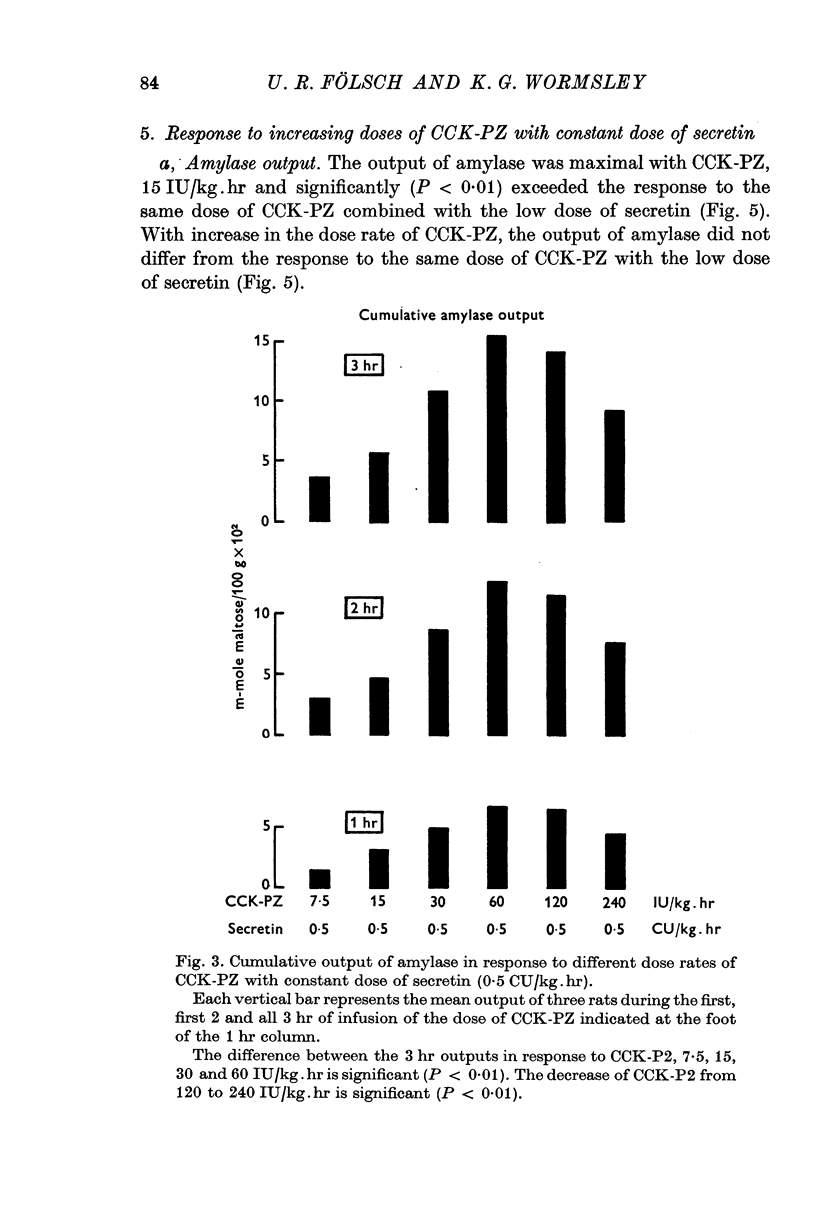
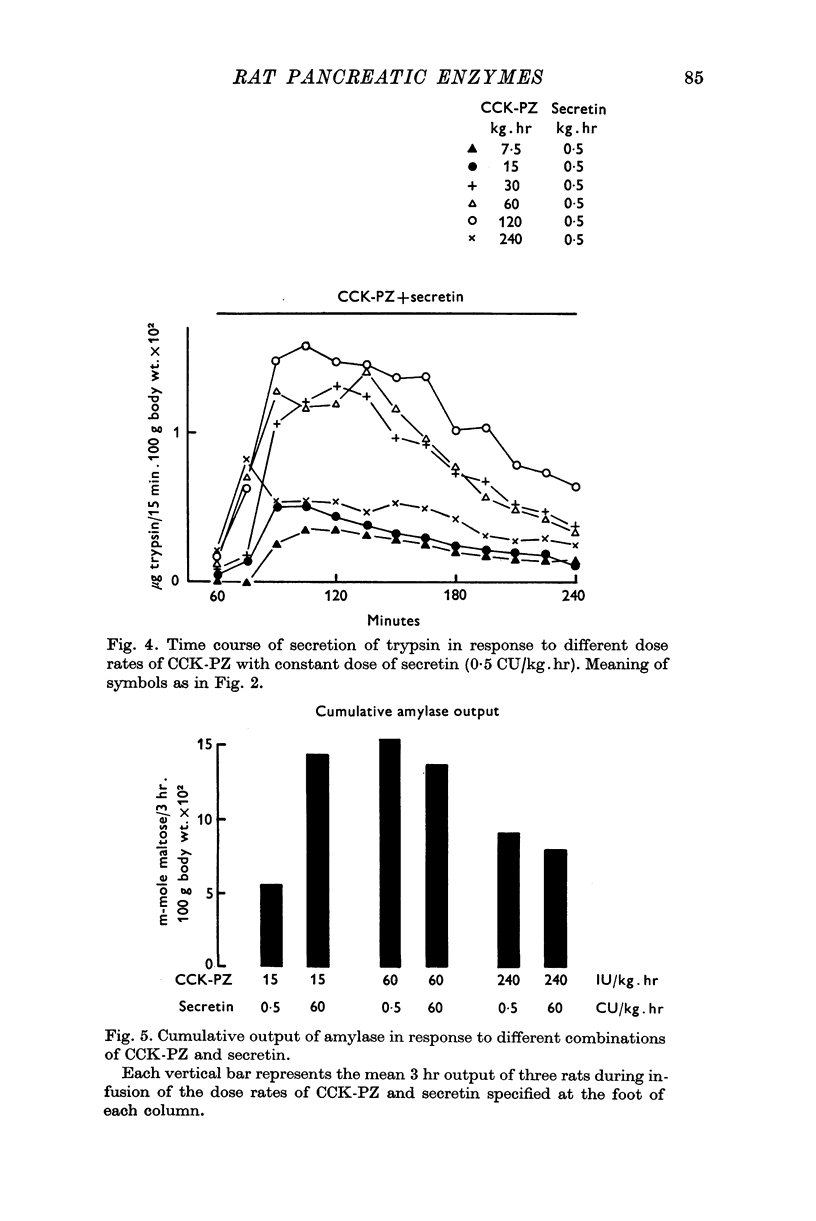
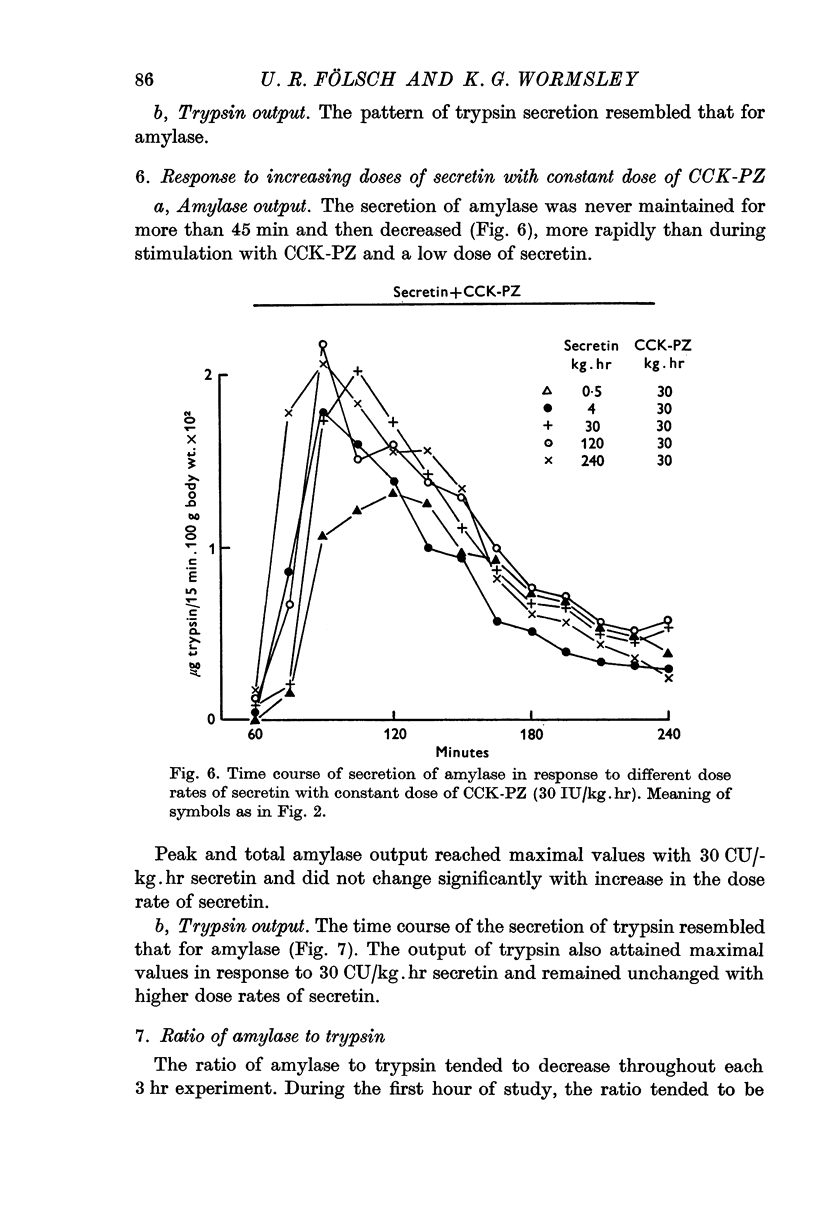
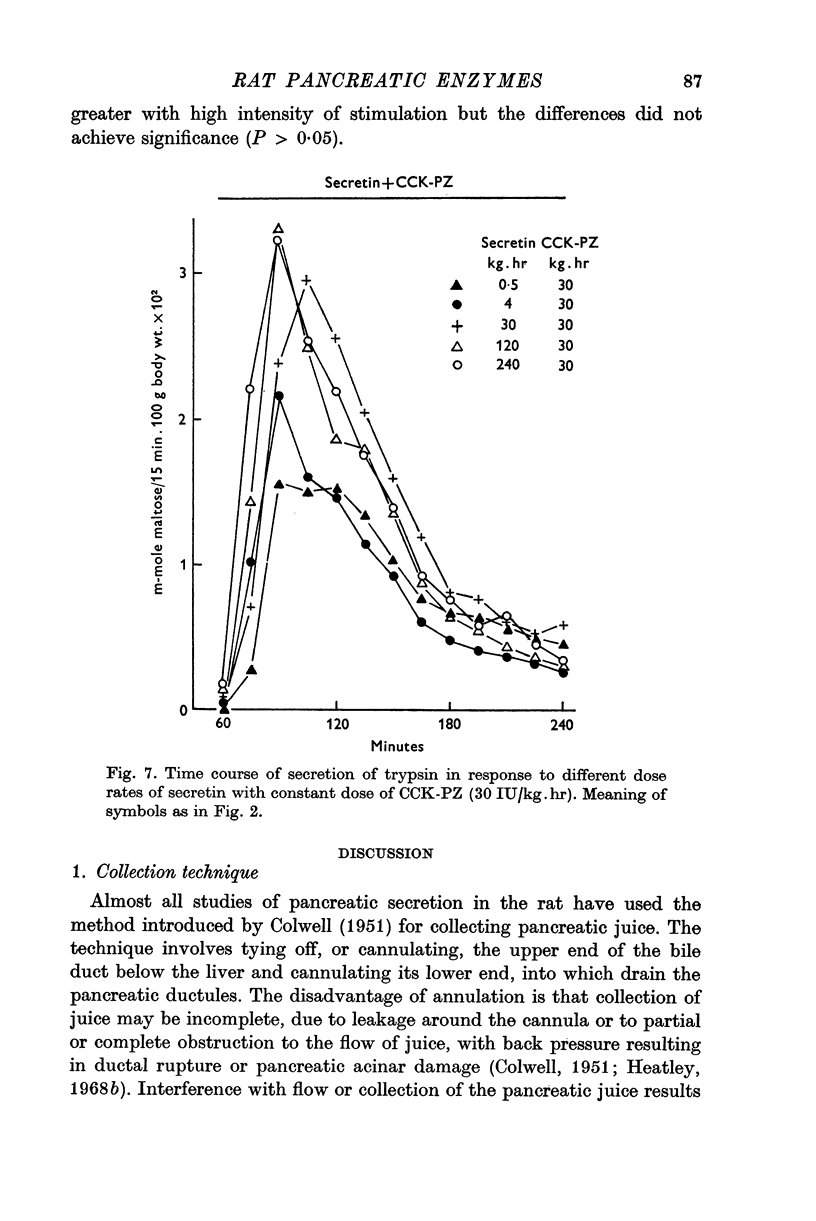
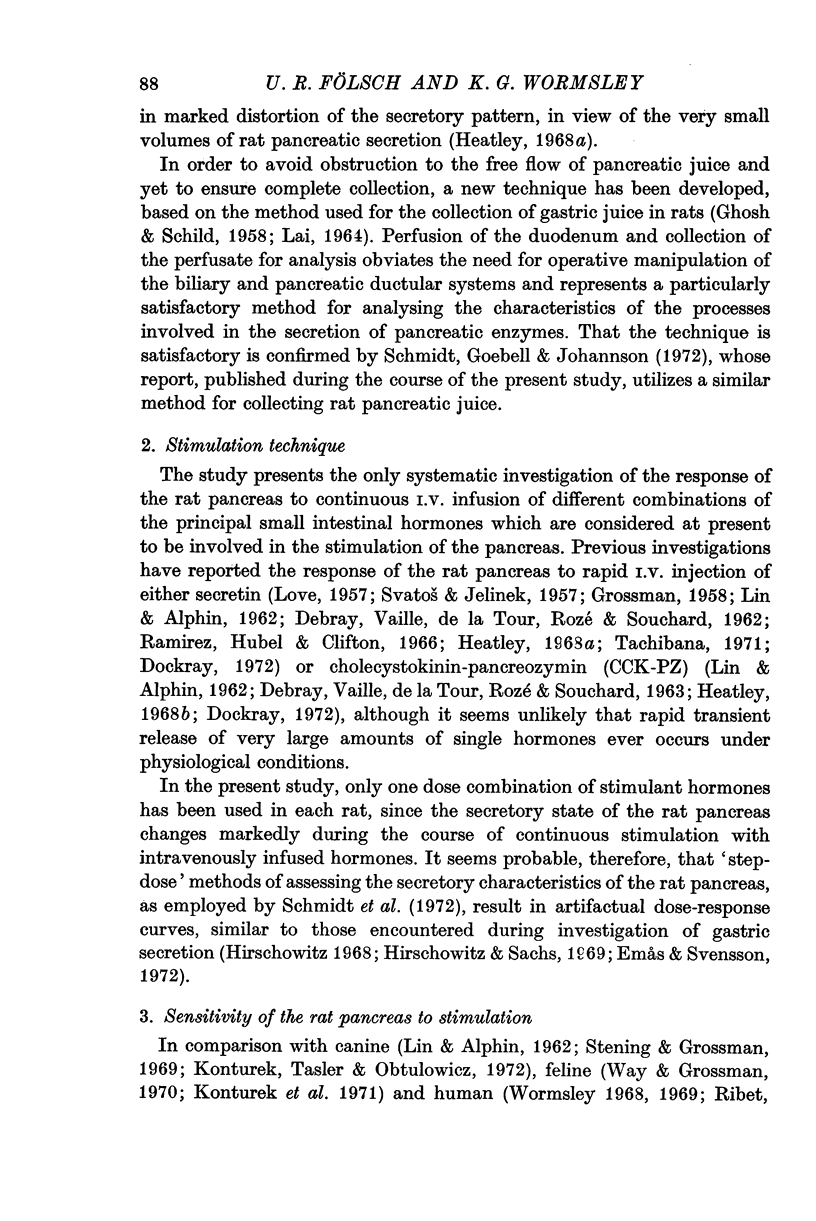
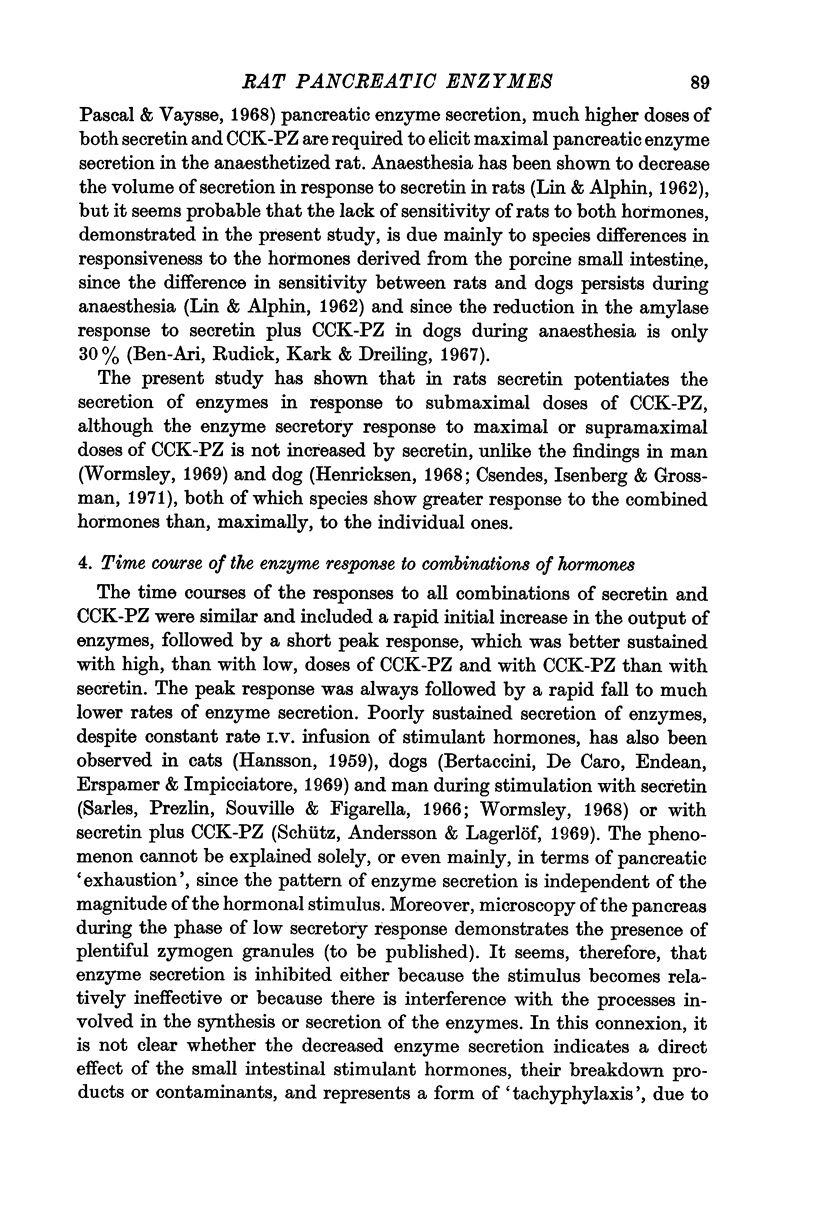
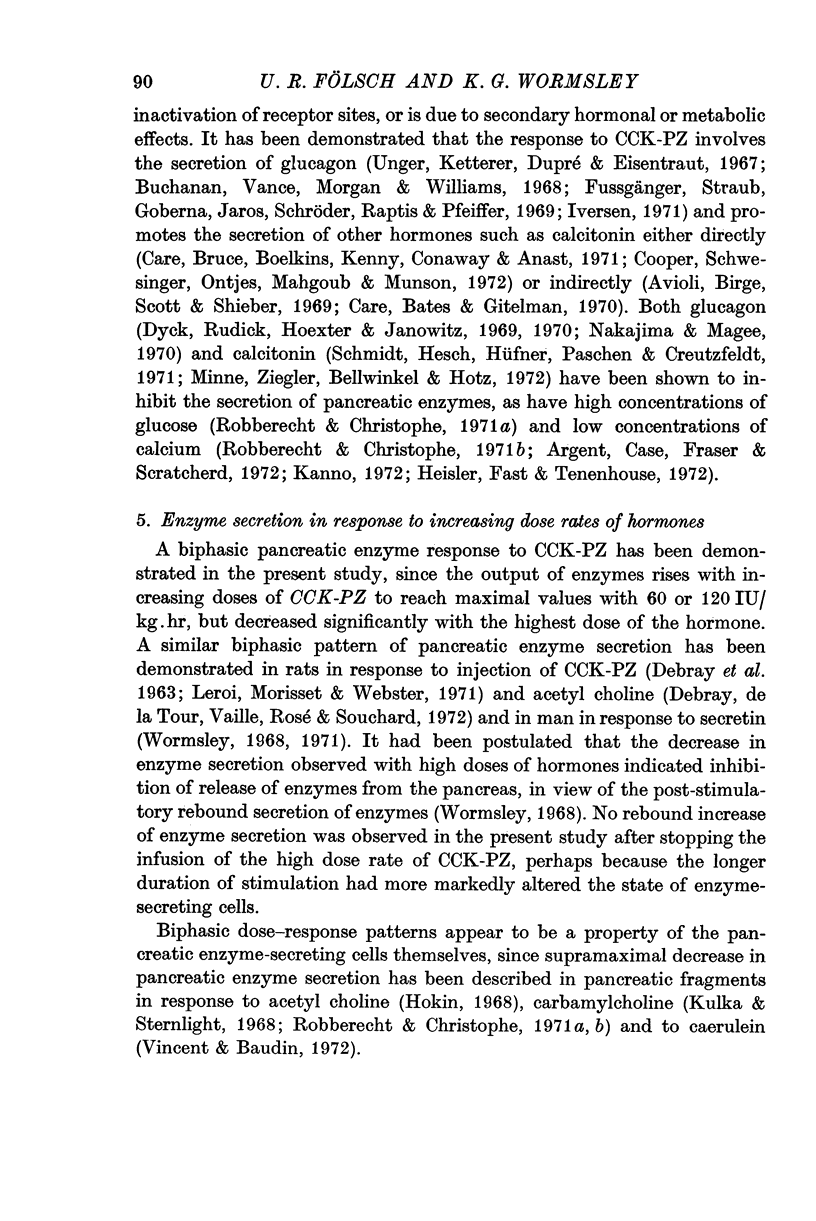
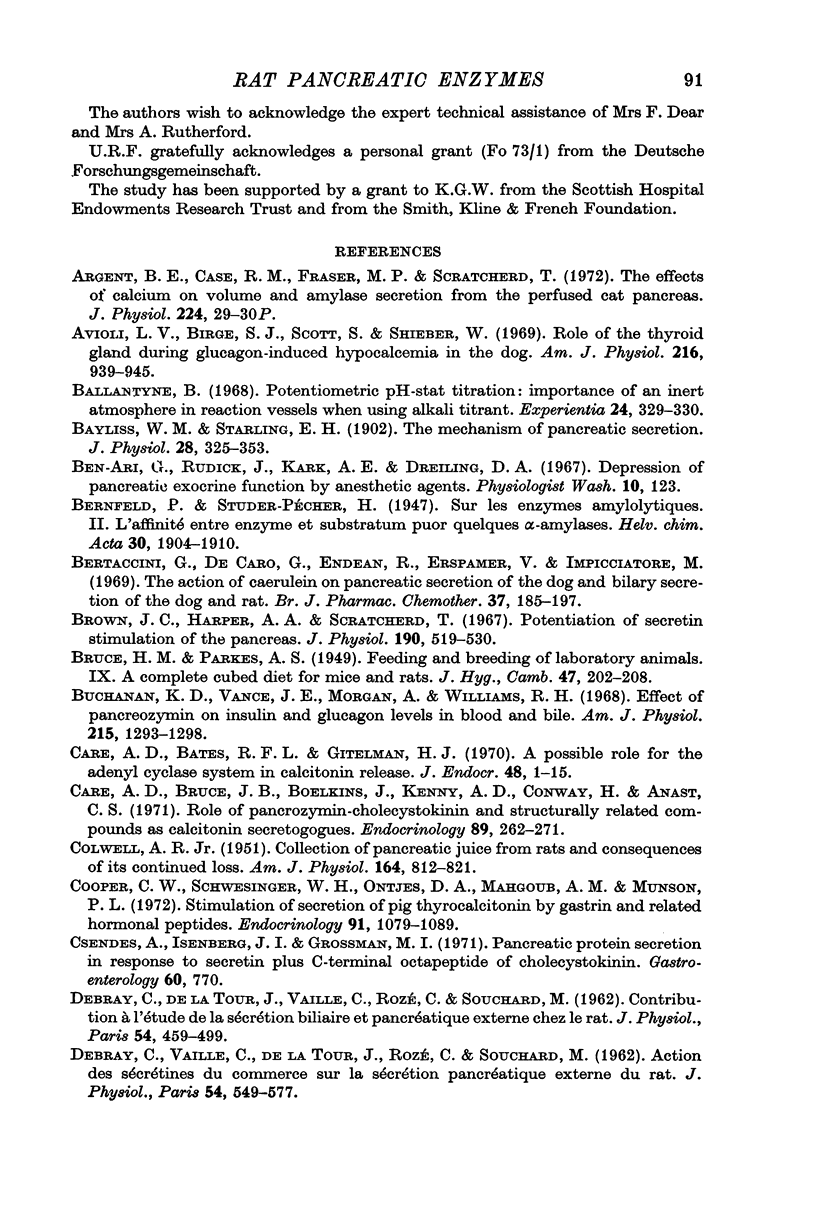
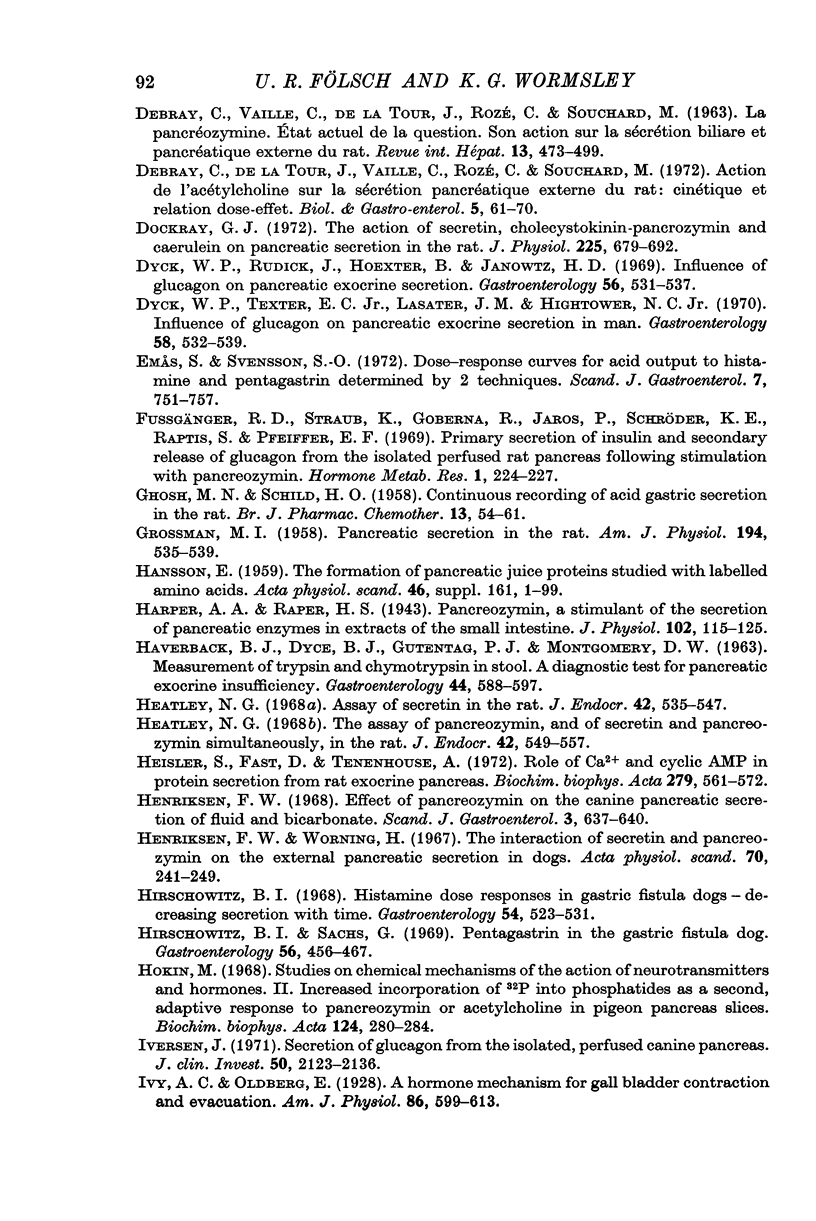
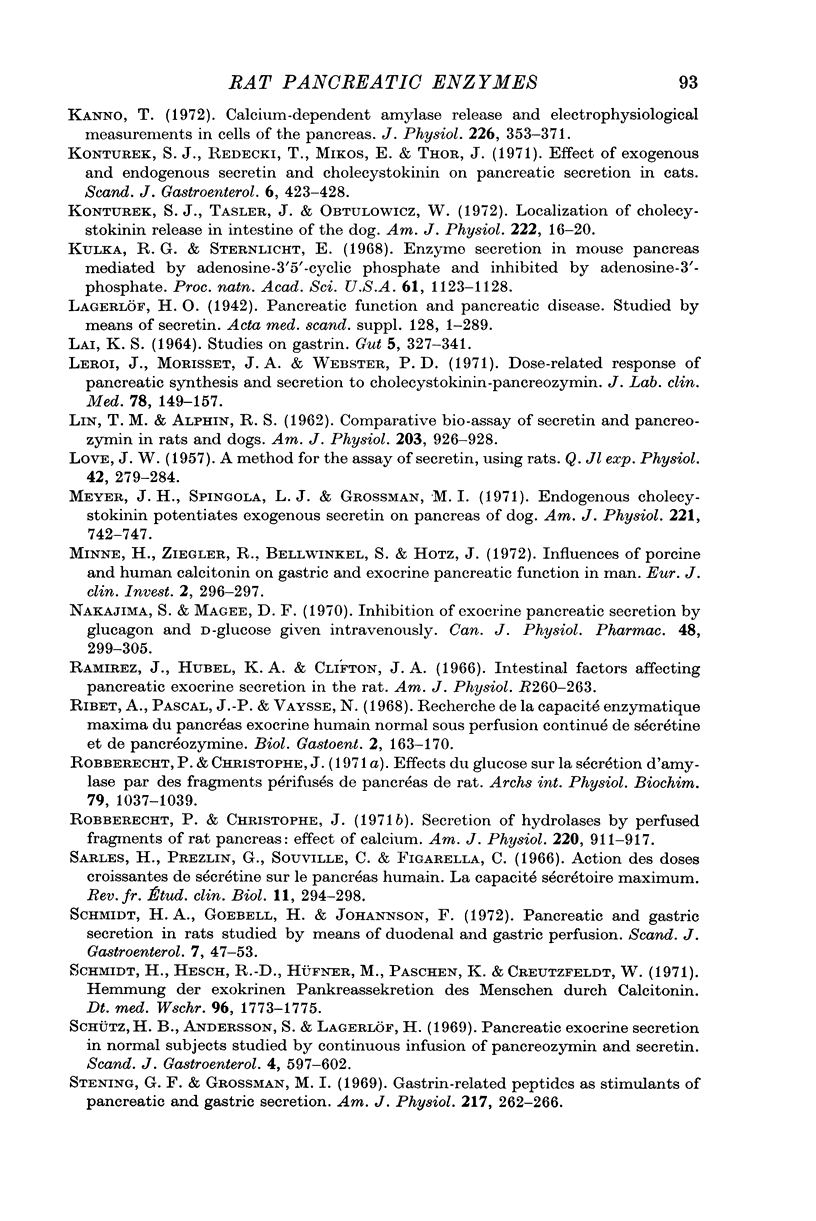
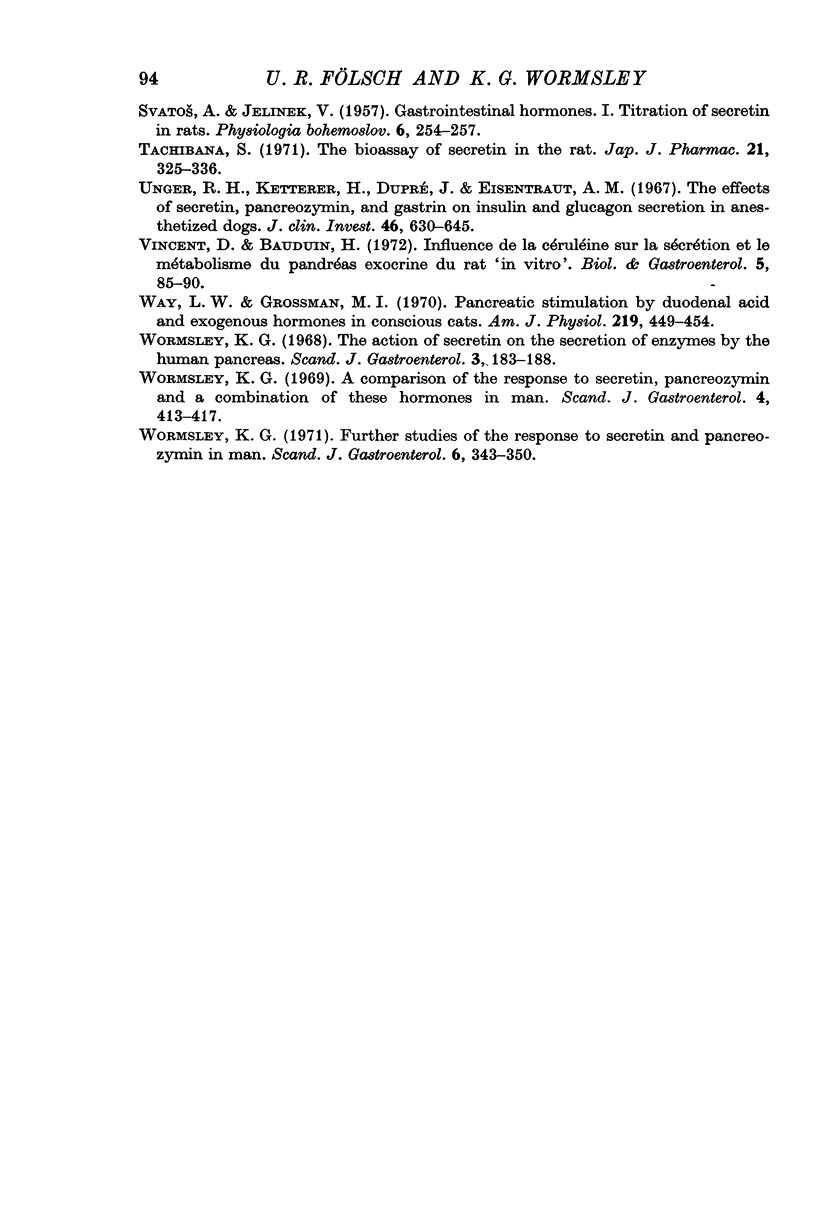
Selected References
These references are in PubMed. This may not be the complete list of references from this article.
- Argent B. E., Case R. M., Fraser M. P., Scratcherd T. The effects of calcium on volume and amylase secretion from the perfused cat pancreas. J Physiol. 1972 Jul;224(1):29P–30P. [PubMed] [Google Scholar]
- Avioli L. V., Birge S. J., Scott S., Shieber W. Role of the thyroid gland during glucagon-induced hypocalcemia in the dog. Am J Physiol. 1969 Apr;216(4):939–945. doi: 10.1152/ajplegacy.1969.216.4.939. [DOI] [PubMed] [Google Scholar]
- BRUCE H. M., PARKES A. S. Feeding and breeding of laboratory animals; a complete cubed diet for mice and rats. J Hyg (Lond) 1949 Jun;47(2):202–208. doi: 10.1017/s0022172400014479. [DOI] [PMC free article] [PubMed] [Google Scholar]
- Ballantyne B. Potentiometric pH-stat titration: importance of an inert atmosphere in reaction vessels when using alkali titrant. Experientia. 1968 Apr 15;24(4):329–330. doi: 10.1007/BF02140800. [DOI] [PubMed] [Google Scholar]
- Bayliss W. M., Starling E. H. The mechanism of pancreatic secretion. J Physiol. 1902 Sep 12;28(5):325–353. doi: 10.1113/jphysiol.1902.sp000920. [DOI] [PMC free article] [PubMed] [Google Scholar]
- Bertaccini G., De Caro G., Endean R., Erspamer V., Impicciatore M. The action of caerulein on pancreatic secretion of the dog and biliary secretion of the dog and the rat. Br J Pharmacol. 1969 Sep;37(1):185–197. doi: 10.1111/j.1476-5381.1969.tb09537.x. [DOI] [PMC free article] [PubMed] [Google Scholar]
- Brown J. C., Harper A. A., Scratcherd T. Potentiation of secretin stimulation of the pancreas. J Physiol. 1967 Jun;190(3):519–530. doi: 10.1113/jphysiol.1967.sp008225. [DOI] [PMC free article] [PubMed] [Google Scholar]
- Buchanan K. D., Vance J. E., Morgan A., Williams R. H. Effect of pancreozymin on insulin and glucagon levels in blood and bile. Am J Physiol. 1968 Dec;215(6):1293–1298. doi: 10.1152/ajplegacy.1968.215.6.1293. [DOI] [PubMed] [Google Scholar]
- COLWELL A. R., Jr Collection of pancreatic juice from rats and consequences of its continued loss. Am J Physiol. 1951 Mar;164(3):812–821. doi: 10.1152/ajplegacy.1951.164.3.812. [DOI] [PubMed] [Google Scholar]
- Care A. D., Bates R. F., Gitelman H. J. A possible role for the adenyl cyclase system in calcitonin release. J Endocrinol. 1970 Sep;48(1):1–15. doi: 10.1677/joe.0.0480001. [DOI] [PubMed] [Google Scholar]
- Care A. D., Bruce J. B., Boelkins J., Kenny A. D., Conaway H., Anast C. S. Role of pancreozymin-cholecystokinin and structurally related compounds as calcitonin secretogogues. Endocrinology. 1971 Jul;89(1):262–271. doi: 10.1210/endo-89-1-262. [DOI] [PubMed] [Google Scholar]
- Cooper G. W., Schwesinger W. H., Ontjes D. A., Mahgoub A. M., Munson P. L. Stimulation of secretion of pig thyrocalcitonin by gastrin and related hormonal peptides. Endocrinology. 1972 Oct;91(4):1079–1089. doi: 10.1210/endo-91-4-1079. [DOI] [PubMed] [Google Scholar]
- DEBRAY C., DE LA TOUR J., VAILLE C., ROZE C., SOUCHARD M. [Contribution to the study of the biliary and external pancreatic secretion in the rat]. J Physiol (Paris) 1962 May-Jun;54:459–499. [PubMed] [Google Scholar]
- DEBRAY C., VAILLE C., DE LA TOUR J., ROZE C., SOUCHARD M. [Action of commercial secretins on the external pancreatic secretion in the rat]. J Physiol (Paris) 1962;54:549–577. [PubMed] [Google Scholar]
- Debray C., de la Tour J., Vaille C., Rozé C., Souchard M. Action de l'acétylcholine sur la sécrétion pancréatique externe du rat: cinétique et relation dose-effet. Biol Gastroenterol (Paris) 1972;5(1):61–70. [PubMed] [Google Scholar]
- Dockray G. J. The action of scretin, cholecystokinin-pancreozymin and caerulein on pancreatic secretion in the rat. J Physiol. 1972 Sep;225(3):679–692. doi: 10.1113/jphysiol.1972.sp009963. [DOI] [PMC free article] [PubMed] [Google Scholar]
- Dyck W. P., Rudick J., Hoexter B., Janowitz H. D. Influence of glucagon on pancreatic exocrine secretion. Gastroenterology. 1969 Mar;56(3):531–537. [PubMed] [Google Scholar]
- Dyck W. P., Texter E. C., Jr, Lasater J. M., Hightower N. C., Jr Influence of glucagon on pancreatic exocrine secretion in man. Gastroenterology. 1970 Apr;58(4):532–539. [PubMed] [Google Scholar]
- Emås S., Svensson S. O. Dose-response curves for acid output to histamine and pentagastrin determined by two techniques. Scand J Gastroenterol. 1972;7(8):751–757. doi: 10.3109/00365527209180992. [DOI] [PubMed] [Google Scholar]
- Fussgänger R. D., Straub K., Goberna R., Jaros P., Schröder K. E., Raptis S., Pfeiffer E. F. Primary secretion of insulin and secondary release of glucagon from the isolated perfused rat pancreas following stimulation with pancreozymin. Horm Metab Res. 1969 Jul;1(4):224–227. doi: 10.1055/s-0028-1095139. [DOI] [PubMed] [Google Scholar]
- GHOSH M. N., SCHILD H. O. Continuous recording of acid gastric secretion in the rat. Br J Pharmacol Chemother. 1958 Mar;13(1):54–61. doi: 10.1111/j.1476-5381.1958.tb00190.x. [DOI] [PMC free article] [PubMed] [Google Scholar]
- GROSSMAN M. I. Pancreatic secretion in the rat. Am J Physiol. 1958 Sep;194(3):535–539. doi: 10.1152/ajplegacy.1958.194.3.535. [DOI] [PubMed] [Google Scholar]
- HANSSON E. The formation of pancreatic juice proteins studies with labelled amino acids. Acta Physiol Scand Suppl. 1959;46(161):1–99. [PubMed] [Google Scholar]
- Harper A. A., Raper H. S. Pancreozymin, a stimulant of the secretion of pancreatic enzymes in extracts of the small intestine. J Physiol. 1943 Jun 30;102(1):115–125. doi: 10.1113/jphysiol.1943.sp004021. [DOI] [PMC free article] [PubMed] [Google Scholar]
- Heatley N. G. The assay of pancreozymin, and of secretin and pancreozymin simultaneously, in the rat. J Endocrinol. 1968 Dec;42(4):549–557. doi: 10.1677/joe.0.0420549. [DOI] [PubMed] [Google Scholar]
- Heatley N. G. The assay of secretin in the rat. J Endocrinol. 1968 Dec;42(4):535–547. doi: 10.1677/joe.0.0420535. [DOI] [PubMed] [Google Scholar]
- Heisler S., Fast D., Tenenhouse A. Role of Ca 2+ and cyclic AMP in protein secretion from rat exocrine pancreas. Biochim Biophys Acta. 1972 Oct 25;279(3):561–572. doi: 10.1016/0304-4165(72)90178-x. [DOI] [PubMed] [Google Scholar]
- Henriksen F. W. Effect of pancreoxymin on the canine pancreatic secretion of fluid and bicarbonate. Scand J Gastroenterol. 1968;3(6):637–640. [PubMed] [Google Scholar]
- Hirschowitz B. I. Histamine dose responses in gastric fistula dogs--decreasing secretion with time. Gastroenterology. 1968 Apr;54(4):523–531. [PubMed] [Google Scholar]
- Hirschowitz B. I., Sachs G. Pentagastrin in the gastric fistula dog. Gastroenterology. 1969 Mar;56(3):456–467. [PubMed] [Google Scholar]
- Iversen J. Secretion of glucagon from the isolated, perfused canine pancreas. J Clin Invest. 1971 Oct;50(10):2123–2136. doi: 10.1172/JCI106706. [DOI] [PMC free article] [PubMed] [Google Scholar]
- Kanno T. Calcium-dependent amylase release and electrophysiological measurements in cells of the pancreas. J Physiol. 1972 Oct;226(2):353–371. doi: 10.1113/jphysiol.1972.sp009988. [DOI] [PMC free article] [PubMed] [Google Scholar]
- Konturek S. J., Radecki T., Mikos E., Thor J. The effect of exogenous and endogenous secretin and cholecystokinin on pancreatic secretion in cats. Scand J Gastroenterol. 1971;6(5):423–428. doi: 10.3109/00365527109180720. [DOI] [PubMed] [Google Scholar]
- Konturek S. J., Tasler J., Obtulowicz W. Localization of cholecystokinin release in intestine of the dog. Am J Physiol. 1972 Jan;222(1):16–20. doi: 10.1152/ajplegacy.1972.222.1.16. [DOI] [PubMed] [Google Scholar]
- Kulka R. G., Sternlicht E. Enzyme secretion in mouse pancreas mediated by adenosine-3'5'-cyclic phosphate and inhibited by adenosine-3'-phosphate. Proc Natl Acad Sci U S A. 1968 Nov;61(3):1123–1128. doi: 10.1073/pnas.61.3.1123. [DOI] [PMC free article] [PubMed] [Google Scholar]
- LAI S. K. STUDIES ON GASTRIN. Gut. 1964 Aug;5:327–341. doi: 10.1136/gut.5.4.327. [DOI] [PMC free article] [PubMed] [Google Scholar]
- LIN T. M., ALPHIN R. S. Comparative bio-assay of secretin and pancreozymin in rats and dogs. Am J Physiol. 1962 Nov;203:926–928. doi: 10.1152/ajplegacy.1962.203.5.926. [DOI] [PubMed] [Google Scholar]
- LOVE J. W. A method for the assay of secretin, using rats. Q J Exp Physiol Cogn Med Sci. 1957 Jul;42(3):279–284. doi: 10.1113/expphysiol.1957.sp001263. [DOI] [PubMed] [Google Scholar]
- Leroy J., Morisset J. A., Webster P. D. Dose-related response of pancreatic synthesis and secretion to cholecystokinin-pancreazymin. J Lab Clin Med. 1971 Jul;78(1):149–157. [PubMed] [Google Scholar]
- Meyer J. H., Spingola J., Grossman M. I. Endogenous cholecystokinin potentiates exogenous secretin on pancreas of dog. Am J Physiol. 1971 Sep;221(3):742–747. doi: 10.1152/ajplegacy.1971.221.3.742. [DOI] [PubMed] [Google Scholar]
- Nakajima S., Magee D. F. Inhibition of exocrine pancreatic secretion by glucagon and D-glucose given intravenously. Can J Physiol Pharmacol. 1970 May;48(5):299–305. doi: 10.1139/y70-049. [DOI] [PubMed] [Google Scholar]
- Ramirez J., Hubel K. A., Clifton J. A. Intestinal factors affecting pancreatic exocrine secretion in the rat. Am J Physiol. 1966 Jul;211(1):260–263. doi: 10.1152/ajplegacy.1966.211.1.260. [DOI] [PubMed] [Google Scholar]
- Ribet A., Pascal J. P., Vaysse N. Recherche de la capacité enzymatique maxima du pancr-eas exocrine humain normal sous perfusion continue de sécrétine et de pancréozymine. Biol Gastroenterol (Paris) 1968;2:163–170. [PubMed] [Google Scholar]
- Robberecht P., Christophe J. Secretion of hydrolases by perfused fragments of rat pancreas: effect of calcium. Am J Physiol. 1971 Apr;220(4):911–917. doi: 10.1152/ajplegacy.1971.220.4.911. [DOI] [PubMed] [Google Scholar]
- Sarles H., Prezlin G., Souville C., Figarella C. Action des doses croissantes de sécrétine sur le pancréas humain. La capacité sécrétoire maximum. Rev Fr Etud Clin Biol. 1966 Mar;11(3):294–298. [PubMed] [Google Scholar]
- Schmidt H. A., Goebell H., Johannson F. Pancreatic and gastric secretion in rats studied by means of duodenal and gastric perfusion. Scand J Gastroenterol. 1972;7(1):47–53. doi: 10.3109/00365527209180738. [DOI] [PubMed] [Google Scholar]
- Schmidt H., Hesch R. D., Hüfner M., Paschen K., Creutzfeldt W. Hemmung der exokrinen Pankreassekretion des Menschen durch Calcitonin. Dtsch Med Wochenschr. 1971 Nov 5;96(45):1773–1775. [PubMed] [Google Scholar]
- Schütz H. B., Andersson S., Lagerlöf H. Pancreatic exocrine secretion in normal subjects studied by continuous infusion of pancreozymin and secretin. Scand J Gastroenterol. 1969;4(7):597–602. [PubMed] [Google Scholar]
- Stening G. F., Grossman M. I. Gastrin-related peptides as stimulants of pancreatic and gastric secretion. Am J Physiol. 1969 Jul;217(1):262–266. doi: 10.1152/ajplegacy.1969.217.1.262. [DOI] [PubMed] [Google Scholar]
- Tachibana S. The bioassay of secretin in the rat. Jpn J Pharmacol. 1971 Jun;21(3):325–336. doi: 10.1254/jjp.21.325. [DOI] [PubMed] [Google Scholar]
- Unger R. H., Ketterer H., Dupré J., Eisentraut A. M. The effects of secretin, pancreozymin, and gastrin on insulin and glucagon secretion in anesthetized dogs. J Clin Invest. 1967 Apr;46(4):630–645. doi: 10.1172/JCI105565. [DOI] [PMC free article] [PubMed] [Google Scholar]
- Vincent D., Bauduin H. Influence de la céruléine sur la sécrétion et le métabolisme du pancréas exocrine du rat in vitro. Biol Gastroenterol (Paris) 1972;5(1):85–90. [PubMed] [Google Scholar]
- Way L. W., Grossman M. I. Pancreatic stimulation by duodenal acid and exogenous hormones in conscious cats. Am J Physiol. 1970 Aug;219(2):449–454. doi: 10.1152/ajplegacy.1970.219.2.449. [DOI] [PubMed] [Google Scholar]
- Wormsley K. G. A comparison of the response to secretin, pancreozymin and a combination of these hormones, in man. Scand J Gastroenterol. 1969;4(5):411–417. [PubMed] [Google Scholar]
- Wormsley K. G. Further studies of the response to secretin and pancreozymin in man. Scand J Gastroenterol. 1971;6(4):343–350. doi: 10.3109/00365527109181131. [DOI] [PubMed] [Google Scholar]


